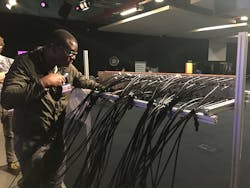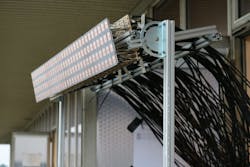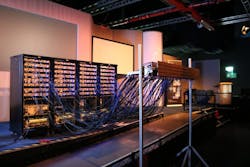NI supports Bristol, Lund 5G field trials at BT nearing 100-b/s/Hz spectrum efficiency
National Instruments has been boosting 5G development through its own efforts as well as through collaboration with universities and other companies. Such efforts have most recently resulted in field trials involving engineers from Bristol and Lund universities and telecom giant BT at BT Labs in Adastral Park, Suffolk, UK.
One potential 5G use case is providing service to a relatively immobile yet high-density group of customers such as might be found in a sports stadium. Consequently, the recent trials took place at a large indoor hall mimicking a sports venue as well as outdoors in the Adastral Park campus.
Researchers, using a flexible SDR platform from NI, said the goals were to test massive MIMO spatial multiplexing indoors and improve the understanding of massive MIMO radio channels under mobile conditions with untethered devices. The team said it obtained promising results indicating that the massive MIMO technology could offer spectrum efficiency figures in excess of the 100 b/s/Hz mark, improving upon the capacity of today’s long LTE systems tenfold.
NI has a history of supporting such 5G research. In a recent email providing comment for an upcoming article on 5G for our April print issue, James Kimery, director, marketing, RF research/SDR at NI, said, “NI established its RF and Communications lead-user program in 2010. Since then, NI has worked with over 50 universities, government research entities, and commercial companies across the world to further the advancement of wireless research through prototyping.”
He added, “NI has worked with Lund University in Sweden and Bristol University in the UK to set new benchmarks for spectrum efficiency. In particular, Bristol University created a Massive MIMO prototype with 128 antennas communicating with 22 UEs to realize an overall system throughput of ~3 Gb/s in just 20 MHz of spectrum, yielding an efficiency mark of 146 b/s/Hz. As spectrum below 6 GHz becomes more scarce, spectrum efficiency becomes more important.”
The recent Bristol, Lund, and BT research involved five PhD students from Bristol’s EPSRC Centre for Doctoral Training in Communications and a researcher from Lund University, who worked with the BT research team, led by Ian Mings, to assess the performance of a 128-element Massive MIMO system operating at 3.5 GHz at BT’s Adastral Park campus.
Initial experiments took place in BT’s large exhibition hall and used 12 streams in a single 20-MHz channel to show the real-time transmission and simultaneous reception of ten unique video streams, plus two other spatial channels demonstrating the full richness of spatial multiplexing supported by the system.
The system was also shown to support the simultaneous transmission of 24 user streams operating with 64QAM on the same radio channel with all modems synchronizing over-the-air. It is believed that this is the first time such an experiment has been conducted with truly un-tethered devices, from which the team was able to infer a spectrum efficiency of just less than 100 b/s/Hz and a sum rate capacity of circa 2 Gb/s in this single 20-MHz wide channel.
In addition to the indoor trials, a series of outdoor experiments were conducted with the array at a height of around 20 meters, enabling far-field array characterization and multi-element handset performance as well as experiments to improve the understanding of the massive MIMO radio channel under mobile conditions to be carried out.
Mark Beach, professor of radio systems engineering in the Department of Electrical and Electronic Engineering and Manager of the EPSRC CDT in Communications, explained in a press release, “We are delighted to be collaborating with BT. Massive MIMO is a key technology for 5G, and the research team’s achievements last year with massive MIMO arrays, which are cellular base stations with more than 100 antennas, demonstrates that this technology could deliver ultra-fast data rates to high densities of smartphones and tablets.”
Professor Tim Whitley, managing director, research and innovation at BT, added, “The BT Labs have a long history of pioneering wireless research, and with the acquisition of [British mobile network operator] EE, we’re excited to once again be at the forefront of mobile technology development. Massive MIMO has the potential to significantly boost available data rates in future 5G mobile networks, and we’re pleased to be able to explore that potential with leading academics in the field at the University of Bristol.”
NI reports that to achieve accurate, real-time performance, the researchers took advantage of FPGAs using LabVIEW Communications and the recently announced NI MIMO Application Framework. As lead users, both the Universities of Bristol and Lund worked closely with NI to implement, test, and debug this framework prior to its product release. It now provides the foundations for the rapid development, optimization, and evaluation of algorithms and techniques for massive MIMO.
The Bristol, Lund, and BT researchers said they are now processing the data sets and aim to publish their findings in leading journals in the near future as well as adding enhancements to the system in preparation for further trials.
About the Author

Rick Nelson
Contributing Editor
Rick is currently Contributing Technical Editor. He was Executive Editor for EE in 2011-2018. Previously he served on several publications, including EDN and Vision Systems Design, and has received awards for signed editorials from the American Society of Business Publication Editors. He began as a design engineer at General Electric and Litton Industries and earned a BSEE degree from Penn State.



